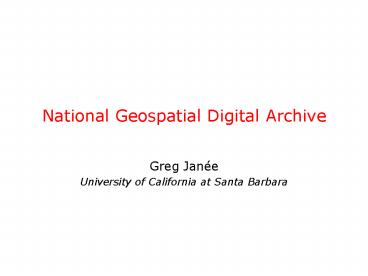National Geospatial Digital Archive - PowerPoint PPT Presentation
1 / 17
Title:
National Geospatial Digital Archive
Description:
Goal: long-term, wide-scale preservation of geospatial data ... crawls provider content; maps content to. archival objects; maintains identifier. associations ... – PowerPoint PPT presentation
Number of Views:29
Avg rating:3.0/5.0
Title: National Geospatial Digital Archive
1
National Geospatial Digital Archive
- Greg Janée
- University of California at Santa Barbara
2
Overview
- One of 8 NDIIPP projects funded by Library of
Congress - joint project with Stanford University
- Goal long-term, wide-scale preservation of
geospatial data - Preservation architecture prototype archive
- single-digit terabytes
- CaSIL GIS datasets, remote-sensing imagery,
aerial photography - Rumsey collection scanned maps
3
Common starting hypothesis
recent content
now take action
4
NGDA starting hypothesis
mid-century perspective
old content
content
ancient content
5
Mid-century perspective
- Repeated migrations across storage media and
storage systems - past and future
- Repeated migrations across archive management
systems - each possibly necessitating transformation and
reorganization of archived content - Repeated handoffs between institutions
- each implementing different policies
6
Mid-century perspective
- Migrations/handoffs may occur asynchronously
- different evolution rates, pressures
- Ability to interpret archived data may change and
deteriorate - Information value, resource levels change over
time - need an ultra-low cost, fallback preservation
mode
7
NGDA architecture goals
- Facilitate migration at all levels
- separate levels to accommodate asynchronicity
- Provide fallback mode
- for individual objects and entire archives
- Capture semantics
- Cheap easy
- or preservation cant be large-scale
8
Semantics
- Def knowledge needed to interpret and use
information that is not shared by the target user
community - Simple documents
- descriptive metadata, format specification
sufficient - Remote sensing imagery
- data interpretation, usage, processing,
calibration - in practice, such semantics are handled
separately - Climate data records
- require periodic reprocessing
9
Ozone reprocessing requirements
- xDRs
- Delivered IPs
- Engineering data (incl. C3S data if not in RDRs)
- Upload files
- Databases
- Software (source code)
- Calibration artifacts
- data
- analysis tools
- tables
- logs
- notebooks
- instrument design
- All project documentation
- All scientific papers
- All reports
Courtesy of Mike Linda, NASA GSFC from 2006
NOAA CLASS workshop
10
NGDA architecture
ingest
access
2
3
registry wiki supports collaborative management
of format registry
ingest crawler crawls provider content maps
content to archival objects maintains
identifier associations
ADL provides spatiotemporal, other types of
search integrated OAI server
webview crawlable, HTML view of archive
SII single item ingest archive management
1
format registry maintains directory of formats
stores specification documents
models inter-format relationships
ADL mapper maps archival objects to ADL items
archive server builds and validates archival
objects associates objects with semantics
NGDA archive data model defines uniform,
self-contained representation of archival
objects, object semantics, and inter-object
relationships
storage API abstracts storage subsystem
5
4
export
reliable storage subsystem Archivas cluster
11
Federation interaction points
- Format registry
- provides a central place for data providers to
describe file semantics, and for archives and end
users to reference those semantics. - Ingest services and tools
- allow data providers to transfer content into an
archive. - Access services
- allow end users to search for and use content
across the entire federation, and allow third
parties to provide value-added access services. - Archive data model
- defines a uniform representation of archive
content archives that implement or map to the
data model can employ NGDA tools to provide
access and export services. - Export function
- transfers archive content in bulk to other
archives for replication and migration purposes
ancillary object semantics are automatically
included.
12
Storage system requirements
- Reqs
- associate UUIDs/RIDs with bitstreams
- retrieve global/local bitstream by UUID/RID
- determine (parent) UUID of any bitstream
- list all UUIDs
- Satisfied by
- any filesystem
- any kind of UUIDs
- taglibrary.ucsb.edu,2005identifier
13
Data model
- Physical implementation of OAIS logical model
- filesystem
- files and directories identified by UUIDs
- XML manifests
- Organizing principle archival object
- individually reusable unit of information
- groups metadata, data, derivatives, etc.
- Inter-object relationships
- semantic definitions
- lineage
- collections and other aggregations
14
Archival objects
UUID
15
Towards a more layered architecture
providers
users
16
Towards a more layered architecture
archive asserts control defines policy
archive object layer defines standard structuring
of content maintains persistent associations to
semantics
storage virtualization layer provides
structure-neutral storage interoperability
between archival, working storage implements
storage policies
17
Questions?































